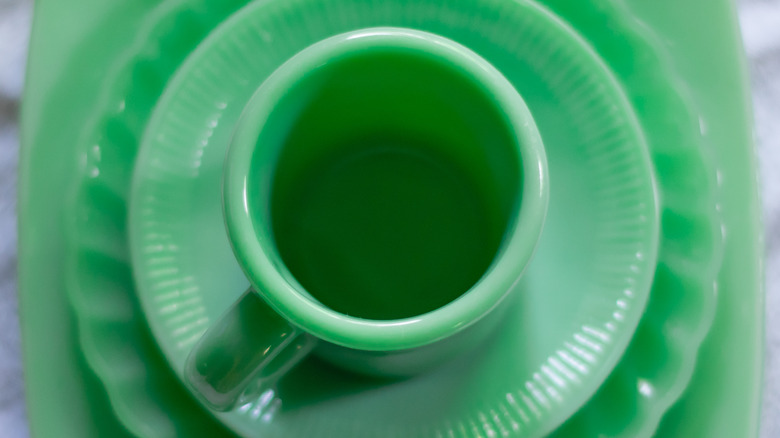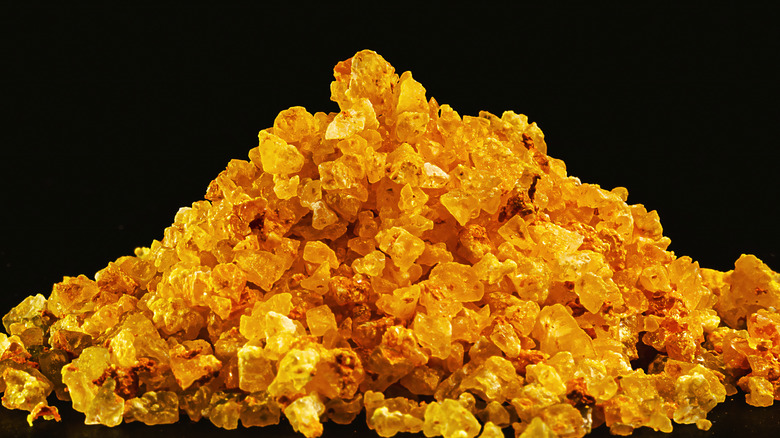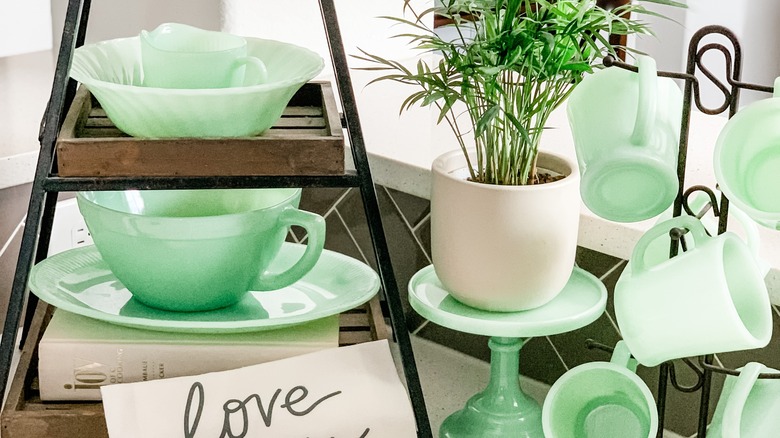Selling This Vintage Household Kitchen Item Could Earn You Up To $1,000
They are milky green. Durable. Sometimes glow in the dark. And, depending on the brand or style, they can be worth hundreds or even thousands of dollars. Called jadeite, it is among the most valuable forms of vintage glass kitchenware, especially if the item was made between the 1930s and 1970s. McKee, Jeanette, and Fire-King are the three most collectable brands of jadeite, per House Digest. The most valuable of these brands is Fire-King, produced by the Anchor Hocking company from 1945 until 1976. A Fire-King product can fetch anywhere from $5 to $1,000. And if that product is a Fire-King casserole dish with a swirl, it can be worth as much as $5,000.
Jadeite, incidentally, is just some of the vintage kitchen and glassware items that may be found at your neighbors' yard sale, or in your local thrift store, that can be worth big bucks. For example, vintage Pyrex can sell for as much as $3,050. Yet jadeite has its own unique history, which started when the United States was dealing with a global financial meltdown.
The evolution of Jadeite, with and without uranium
Jadeite glassware was invented during the height of the U.S. Depression in 1930 by the McKee Company. The company's "Skokie Green" dishes were made from scraps of green glass and a "brand-new opaque material," Pam Franscella, a member of the National Depression Glass Association, explained in a 2018 seminar that was recorded on YouTube. The product did so well that the Jeanette Glass Company launched its own green glass product line in 1932, under the name Jadeite due to its likeness to the jade stone. Jadeite dishware was also cheap to manufacturer and very tough. And if the dishes were made by McKee and Jeanette, they tend to glow at night, or under a dark light. Reason: Prior to World War II Glass companies often used uranium glass for color. Because they radiate only tiny amounts of radiation, they are still safe to eat and drink from, according to an article from Michigan State University.
By the time Anchor Hocking started selling Fire-King products in 1945, uranium was a heavily regulated element used for manufacturing atom bombs and no longer used as a color additive. So, a Fire-King dish or cookware can't be used as a nightlight. Nevertheless, Fire-King items are extremely tough and built to last a very long time. As a result, Fire-King is the most sought-after jadeite product in the world.
At least, now they are. As early as the 1950s, jadeite fell out of favor and the dishware was often thrown away. But that started to change in the late 1990s when Martha Stewart featured jadeite on her shows. The values fell again until 2008 when there was a jadeite resurgence, "and it has been going up ever since," depression-era glass expert Franscella said during her YouTube recorded talk.
But how do you know if that piece is really vintage jadeite?
To figure out if that milky green cup or dish is actually vintage jadeite, Antique Answers recommends a "toss test." That's when a small piece is tossed into the air and caught. If the item is heavy, it might be authentic vintage jadeite. If it is light, it's a product that was made using new processes in the 1980s—and not vintage.
To identify larger pieces, especially if it's a Fire-King item, take a hard look at the markings, advises Fire-King Grill, a blog dedicated to Fire-King products. For example, a dish made between 1945 and 1948 with a "oven-fire king glass" marking or the Anchor Hocking logo are worth a lot of money. After 1962, authentic Fire-King pieces came with the Anchor Hocking anchor logo.
But if you are just a fan of tough, green glassware, feel free to bargain hunt online. Companies are using new techniques to create their own lines of jadeite reproductions. Martha Stewart, an enthusiastic collector of jadeite products, even created her own line of jadeite until 2004. These newer products are worthless now, but that might change in a few decades if companies stop making them.


